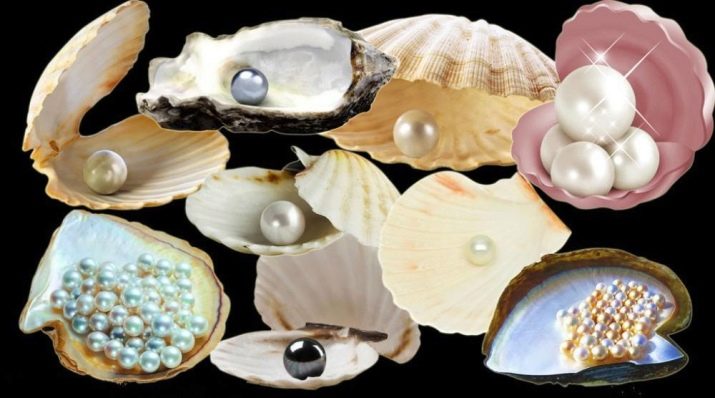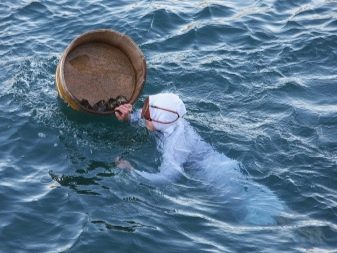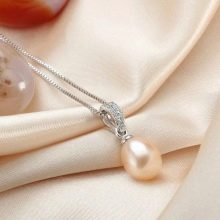Pearls are solid round or irregular mineral formations. Appears inside the shell of a marine mollusk as a result of biogenic processes. It is a precious material from which jewelry is made.
The most outstanding pearl specimen ever found in the natural environment is the pearl of Lao Tzu. Its other name is the Pearl of Allah. Her weight is 34 kg, length - 67 cm, width - 30 cm.

The formation of pearls in natural conditions is an extremely complex process, marked by a wide range of physical and chemical reactions that occur in the shell body.
Process description
The formation of pearls is a protective reaction of the mollusk organism. It is activated when a foreign body enters through the open shell leaves. This may be a grain of sand, small pebbles, algae or something else. In order to eat, as well as move along the seabed, the oyster is forced to open the wings of its shell. It is at the moment of opening, under the influence of water pressure and buoyancy, foreign bodies penetrate into the house.
The body of the mollusk is extremely tender, equipped with many sensitive receptors. The presence of such features makes him use a protective mechanism that does not allow a foreign body to harm him.
- A foreign body settles on one part of the surface of the mollusk. After which it begins to gradually sink into the tissue. The result is a small depression on the surface of the body. The formation of the so-called pearl bag.
- Foreign inclusions can have sharp edges and corners that irritate and even injure the delicate body of the mussel. The irritation factor causes the launch of biological processes leading to the production of special cells by the body.
- These cells are sent to the place where the foreign object is located. A special enzyme contained in cells makes them envelop a grain of sand with mineral-organic layers. Wrapping occurs gradually, layer by layer. After solidification, a hard surface is formed. So the pearl is born.

The shape of the pearl depends on the configuration of the grains of sand, which fell into the internal environment of the mollusk. If it has a fairly even shape, the pearl will turn out in the form of a regular ball. In other cases, an irregular or oblong object gets inside the sink. The future pearl will be coated with a mineral-organic layer in accordance with the shape of a foreign body. The result can be a pearl with a curved surface.
The degree of symmetry of the shape of the pearl is affected by the location of the foreign body. In some cases, it may settle on the inside of one of the shell flaps, which leads to the pearls splicing with the flap surface. Such pearls become one with the shell of the mollusk and is not a valuable material.

Depending on the variety of the mollusk and its habitat, the qualitative characteristics of the pearls it grows may differ. Differences can be observed in the color, shape, texture of pearls, as well as in the presence or absence of other individual characteristics.
The extraction of pearls grown in nature inside the oyster is an extremely time-consuming process. Typically, a mollusk shell lies on the surface of the seabed. For its extraction, it is necessary to go down to the very bottom, which can be dangerous for an unprepared miner.

In addition, pearls in mussels grow for a very long time. The formation of a mineral layer around a foreign body proceeds at the cellular level. To reach a pearl of an acceptable size, you may need some years. To facilitate the process of mining a precious mineral, modern technologies are used. The technique allows you to dive to great depths and stay there longer than usual.
There are oyster farms. The purpose of their activity may be to obtain a food product or artificial pearl.

Mussel breeding technology involves use of an artificial or natural reservoir. In the second embodiment, a certain section of the water body is fenced off from the main one. In the case of breeding of marine mollusks, part of the marine coastal space is used, since it is almost impossible to create similar conditions in isolation from the sea.
The size of each individual pearl depends on the size of the shell of the mollusk that grows it. In addition, the physical condition of the oyster affects the value. If it is healthy and strong, the process of pearl stone formation will proceed faster, with a better result.

Some representatives of mollusk appear to be incapable of a long process of enveloping foreign inclusions. They do not have enough resources necessary for this, which becomes the reason for their death. In the conditions of farm breeding, such cases are unprofitable, since the mussel can die before it can form a full-fledged pearl.
Physical properties of stone
In the list of physical properties of pearls, the main ones can be distinguished:
- color;
- the form;
- shell composition.

The most common color combination of a pearl is white with a shiny pearly sheen. However, there are also colored pearls of pink, blue, purple, brown, orange hue.Color characteristic is the determining indicator on which the price of a product depends. The rarest and most expensive pearls are blue and blue. They are grown by the mollusk heliotis.
The shape of each individual pearl is a factor that directly affects its value. A more regular form is much more expensive than an irregular one. In addition, there are pearl formations, the shape of which does not allow their use in any way. In this case, they are recognized as defective material and disposed of.



The cheapest and most affordable is the pearl made by freshwater mussels. Its cost is extremely low, and the quality is mediocre.
The main characteristic of the pearl is the composition of its shell. A distinctive feature of this material is its special chemical composition, its main constituent components are calcium carbonate and conchiolin. Thanks to the combination of these elements, pearls are half mineral, half organic formation, which emphasizes its uniqueness.


Mining locations
Mussels, growing pearls inside their shell, live in warm sea and ocean waters. They can be found near the coast of South America, Australia, Japan, India and others.
The average depth of their permanent stay is 30-35 m, however, representatives of this species of marine inhabitants are also found at a much greater depth. Over the course of its life, an oyster can travel long distances, despite its limited mobility. In most cases, the mollusk attaches its house to some hard surface: a stone or a coral reef. In this position, he can be quite a long time.


Search and mining of pearl mussels is carried out at an average depth of up to 20 m. In most cases, professional divers will pick them up from the bottom, diving into the water without special equipment. This work is associated with great physical exertion and a high probability of harm to health, which is one of the factors determining the cost of pearls. The outer surface of the shell of some mollusks has a specific color, merging with the environment. This greatly complicates their search.
Wild oyster production is a factor that negatively affects the ecosystem of the underwater world. Good quality pearl formations are rare. Out of ten oysters, only one can contain a pearl.
Those mollusks that do not have a gem in themselves die as a result of opening their shells. The numerical population of the species suffers from this, which causes them to go into deeper waters.


Scope of application
Mostly pearls are used to make various jewelry. From it they make:
- beads;
- necklace;
- bracelets;
- earrings;
- rings;
- pendants;
- brooches;
- custom products.



Jewelry, which consists of a certain number of pearls, is considered the most expensive. For example, for making a bead or necklace, stones are selected that are similar in size, shape and shade. The production of such a selection is a labor-intensive process, since in nature there are no two absolutely identical pearls.
Items containing 1 or 2 pearls are slightly cheaper, but the final cost is also affected by the material from which the frame is made. Platinum or gold frames that frame the pearl are an order of magnitude higher.



It is believed that pearls have magical properties and can affect the physical or psychological state of a person. However, real facts confirming such conclusions were not revealed.
If we talk about the effect of pearl jewelry on a person, then it is worth noting the following: the presence of such an exquisite and expensive jewelry made from natural material raised from the seabed forms a special human status and increases self-esteem.
The bearer of such an ornament may feel special, standing out from other people. Based on this, we can conclude that a pearl product is able to influence the person’s inner sense of self. This influence is due to its emotional background, but not to the magical properties of the natural mineral-organic compound.


See how to distinguish natural pearls from fakes in the video below.










